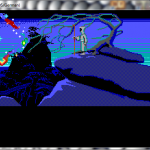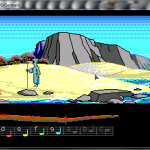 Among some other games I recently rediscovered the 3.5” disc version of the LucasArts (née Lucasfilm Games) classic Loom. Released in 1990, this game is based on the same version of the SCUMM game engine used by The Secret of Monkey Island (see my earlier review). I had bought the game sometime in the mid- to late 90s, played through it once, and then pretty much forgotten about it. All I could recall was that it came with an audio cassette tape, and that the game’s puzzles were based around music somehow. Sadly, I couldn’t find the tape any more, but some research revealed that it mainly introduces the game’s setting and main characters, but is otherwise not necessary.
Among some other games I recently rediscovered the 3.5” disc version of the LucasArts (née Lucasfilm Games) classic Loom. Released in 1990, this game is based on the same version of the SCUMM game engine used by The Secret of Monkey Island (see my earlier review). I had bought the game sometime in the mid- to late 90s, played through it once, and then pretty much forgotten about it. All I could recall was that it came with an audio cassette tape, and that the game’s puzzles were based around music somehow. Sadly, I couldn’t find the tape any more, but some research revealed that it mainly introduces the game’s setting and main characters, but is otherwise not necessary.
So, without further ado, I decided to jump into the game. In it, you get to control the character of Bobbin Threadbare, a young member of the weavers’ guild, in classic point-and-click manner. While the overall graphics resemble those of other early LucasArts titles, there are some pretty significant differences: the usual array of verbs that let you interact with your environment is missing, just as there is no inventory of items you get to carry around with you. Instead, you interact with the world by using a magical staff to weave four-note tunes.
 Each action is represented by a different tune, which you learn by observing objects around you: for example, you can learn to see in the dark by observing a group of owls. Some tunes can be played in reverse, thereby also reversing their effects. Over time, as you become more capable of playing notes, you learn up to about a dozen different spells. Even though this system really just hides the underlying verb system of similar titles, it does so quite convincingly, especially because you do not have access to all actions right away.
Each action is represented by a different tune, which you learn by observing objects around you: for example, you can learn to see in the dark by observing a group of owls. Some tunes can be played in reverse, thereby also reversing their effects. Over time, as you become more capable of playing notes, you learn up to about a dozen different spells. Even though this system really just hides the underlying verb system of similar titles, it does so quite convincingly, especially because you do not have access to all actions right away.
 For the first half of the game, you try to find out what happened to the guild elders, after they turned into swans and flew away. In the course of this, you encounter other guilds, such as the shepherds and blacksmiths, and an ill-tempered dragon. You finally find out, that an evil priest is attempting to disrupt the fabric of existence in order to break down the barrier between the living and the dead. You are then in charge of fixing the damage of his actions and prevent the forces of chaos from taking over.
For the first half of the game, you try to find out what happened to the guild elders, after they turned into swans and flew away. In the course of this, you encounter other guilds, such as the shepherds and blacksmiths, and an ill-tempered dragon. You finally find out, that an evil priest is attempting to disrupt the fabric of existence in order to break down the barrier between the living and the dead. You are then in charge of fixing the damage of his actions and prevent the forces of chaos from taking over.
In typical LucasArts fashion, you cannot die from doing something wrong, so it pays of to try almost every possible tune on any object you encounter. That being said, you probably won’t have much need for this, as the puzzles in Loom are very straight-forward and can mostly be solved without too much effort. Given the low level of difficulty, I was rather surprised when I got to the end of the game after a mere 3 hours. I still had not learned all the tunes that the manual mentioned, but after consulting some walkthroughs it appears that is intentional, as they were intended to be used in potential sequels which were never made.
 In conclusion, Loom is built on an interesting premise that could have used more content. The graphics and music especially are excellent given the technical limitations of the period. Ultimately, though the lack of any real challenge as well as the short duration make it a somewhat forgettable experience.
In conclusion, Loom is built on an interesting premise that could have used more content. The graphics and music especially are excellent given the technical limitations of the period. Ultimately, though the lack of any real challenge as well as the short duration make it a somewhat forgettable experience.
Leave a Reply